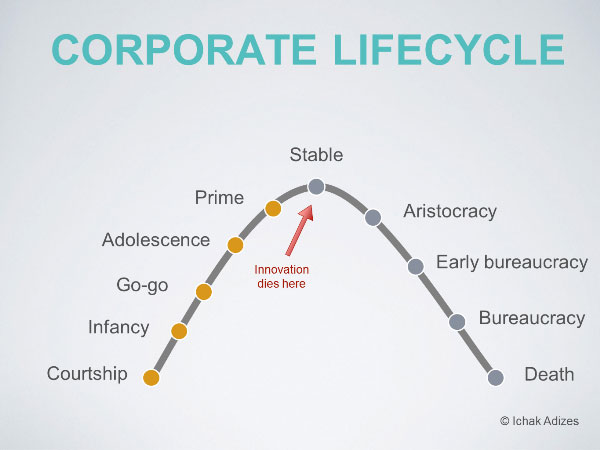-
-
-
-
URL copied!
Business success is a temporary thing: competition urges companies to be effective and innovative in order to keep their market edge. Startups intrinsically understand this principle, which is why they are able to achieve great results without having many resources. So what can large companies learn from startups about innovation, and how can an organization’s greatest resource — its people — contribute to this innovation?
My Experience as a “Startupper”
Two years ago, I participated in hackathon for the first time. During this event, spontaneous teams of strangers embodied their ideas in prototypes (e.g., web, mobile, hardware) over a weekend. I met fantastic people who had one common feature (apart from being highly qualified specialists): they eagerly wanted to make the world a better place. For 48 hours, these people passionately coded, designed, explored markets, shot videos, and rehearsed their pitches. They worked without thinking of creature comforts, and they only took a few hours to sleep. But exhausted as they were, they were driven by realizing their ideas.
At that hackathon, which was held at Kyiv Polytechnical Institute, my team unexpectedly took the first place. Our product, motify.me, was focused on helping people achieve their dreams through communicating with those who have already achieved them. In just a few months, with our poorly working prototype and an engaging PowerPoint presentation, we received seed investments in exchange for a share in our startup. Hence, I suddenly became the co-owner and shareholder of an American company with a Ukrainian investor.
Although we eventually decided to close down the project, the experience compelled me to analyze the operational activities of startups and big companies — especially since it seemed that startups are often more effective. Initially, it seemed that the key was the company’s size. However, it soon became obvious that it wasn’t the size of the company that mattered, but its ability to quickly and effectively make decisions, its entrepreneurial flexibility, its absence of bureaucracy, its ability to choose the most up-to-date technologies and approaches, etc. In order to condense these factors into a single word, I’ll use the term “innovation.”
Why do Companies Need Innovations?
I don’t think anybody has systematized a company’s lifecycle better than Ichak Adizes did. The idea is that, from Infancy to Prime (terms used by Adizes), a company stays flexible, has a strong intrinsic entrepreneurial component in management, and is focused on growing and winning its place in the market. After a company finds and securely occupies this place (i.e., Stability stage), experimenting with new ideas becomes a lower priority than administrating.
Paradoxically, companies start to need innovations most when they reach their mature stages (i.e., Stability to Early Bureaucracy). This is the reason why they swallow up their competitors, which appear to be more flexible and promising (e.g., Facebook’s acquisition of WhatsApp and Instagram). Through this approach, corporations can feel “young” again and strengthen their positions in the market.
It’s encouraging to see that GlobalLogic, a mature company, cultivates a culture of openness to new ideas. For instance, it holds an annual proof-of-concept (POC) contest in which the company’s consultants can play the role of a startupper and realize their boldest ideas. It’s also interesting to note that some of these POCs become actual GlobalLogic products, which provides a path to a much more interesting business model.
Where to Start?
In order to maintain its success, a company should track innovations, including technologies, processes, marketing, people management, etc. It is especially important to track technologies, which tend to change quickly. (And naturally, it has the biggest importance for technological companies.) Below are some steps that managers can take to drive innovation within an organization:
Challenge traditional approaches
- Use your teams’ creativity to complete tasks that you have previously completed by yourself
- Intensify cooperation with other departments and managers – you’ll notice that you have many common interests
- Turn staffing into an exciting process both for candidates and yourself
- Consider what else you can do for your clients
Cultivate an entrepreneurial spirit
- Set ambitious goals and give more freedom to your people
- Attend startup events, either by yourself or with your team
- Initiate a hackathon within your company
Evolve and educate your staff
- Practice distance learning for yourself and your teams (e.g., Stanford, Udacity, and other online courses)
- Organize a team viewing of TED Talks
- Refresh your corporate library
- Participate in professional conferences
On an individual level, each of us can make our company great. Below are several books that can help with your endeavors:
Innovator’s Dilemma – Clayton Christensen
- An innovator’s Bible, this book helps readers understand how breakthrough innovations differ from supporting ones, why some companies fail even when the managers do everything right, etc.
Good To Great – Jim Collins
- This book focuses on how to turn a good company into a great one through stories about prominent leaders and enterprises.
Lean Startup – Eric Ries
- This book explores the adaptation of “lean principles” in business (i.e., a way to reach the greatest results with a minimal budget in conditions of uncertainty).
Managing Corporate Lifecycles – Ichak Adizes
- This book delves into managing the corporate lifecycle.
Organizational Culture and Leadership – Edgar H. Schein
- This book focuses on the leader’s role in incorporating culture development.

Summary
In order to stay successful in business, you shouldn’t remain satisfied with achieved results. History has shown us many examples of leading companies who have had to give ground to talented and diligent newcomers. The truly great companies are the ones that eagerly evolve so as to preserve their market leadership. Innovative thinking is the foundation of their success.
Yuriy Koziy is a senior consultant at GlobalLogic’s Kyiv center with over ten years of product engineering and development experience. He most recently shared his startup and management experience as a guest speaker at the Lviv Project Management Day 2014 conference.
Top Insights
Innovators and Laggards: The Technology Landscape of 2019
Digital TransformationPerspectiveAutomotiveCommunicationsConsumer and RetailFinancial ServicesHealthcareManufacturing and IndustrialMediaTechnologyTop Authors
Blog Categories

Let’s Work Together
Related Content
GenAI in Action: Lessons from Industry Leaders on Driving Real ROI
Generative AI (GenAI) has the potential to transform industries, yet many companies are still struggling to move from experimentation to real business impact. The hype is everywhere, but the real challenge is figuring out where AI can drive measurable value—and how to overcome the barriers to adoption. In the latest episode of Hitachi ActionTalks: GenAI, … Continue reading The Innovation Race: Startups vs. Corporations →
Learn more
Unlock the Power of the Intelligent Healthcare Ecosystem
Welcome to the future of healthcare The healthcare industry is on the cusp of a revolutionary transformation. As we move beyond digital connectivity and data integration, the next decade will be defined by the emergence of the Intelligent Healthcare Ecosystem. This is more than a technological shift—it's a fundamental change in how we deliver, experience, … Continue reading The Innovation Race: Startups vs. Corporations →
Learn more
Leveraging SaMD Applications to Improve Patient Care and Reduce Costs
One of the most exciting developments in healthcare is the emergence of Software as a Medical Device (SaMD) as a more convenient and cost-effective means to deliver superior care to the tens of millions of people worldwide who suffer from various health conditions.
Learn more
Share this page:
-
-
-
-
URL copied!


